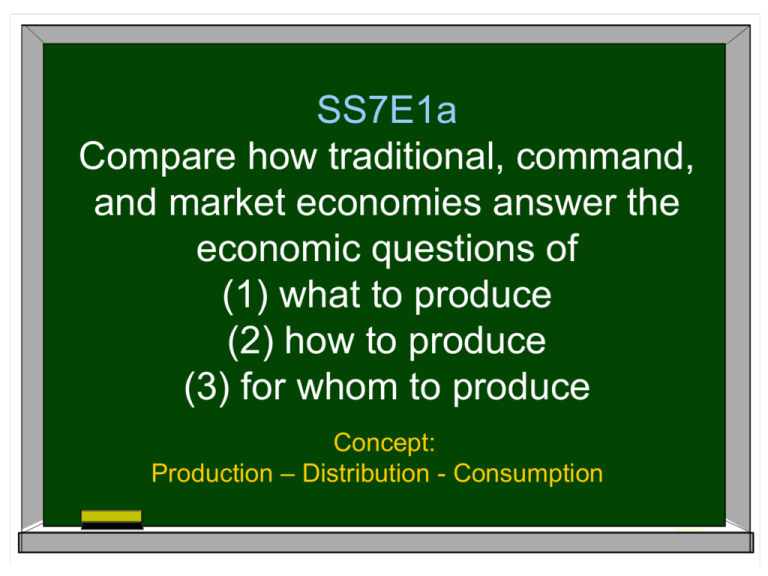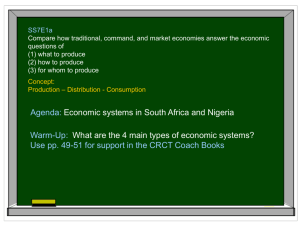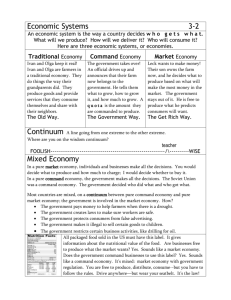how to produce
advertisement

SS7E1a Compare how traditional, command, and market economies answer the economic questions of (1) what to produce (2) how to produce (3) for whom to produce Concept: Production – Distribution - Consumption ECONOMIC SYSTEMS TRADITIONAL ECONOMIC SYSTEMS MARKET COMMAND SS7E1b Explain how most countries have a mixed economy located on a continuum between pure market and pure command. Concept: Production – Distribution - Consumption ECONOMIC CONTINUUM PURE MARKET ECONOMY MIXED ECONOMY PURE COMMAND ECONOMY • Individuals and private businesses DECIDE what is produced, how it is produced, and who they will sell to • Individuals and private businesses AND governments DECIDE what is produced, how it is produced, and who they will sell to • The Government DECIDES what is produced, how it is produced, and who they will sell to SS7E1c Compare and contrast the economic systems in South Africa and Nigeria. Concept: Production – Distribution - Consumption Private sector – run by people Government sector – run by the govt. Economy of South Africa What to produce? A large part of South Africa’s GDP comes from a highly developed, privatized enterprise system much like many other developed countries. The private sector is based on mining, agriculture, services, and manufacturing. Due to problems in the past (Apartheid), the government operates a large part of the social services sector and maintains state-run enterprises in housing, business development, education, and healthcare. Economy of South Africa How to produce? In the developed sector, private businesses and consumers make production decisions based on market principles (supply and demand). The Reconstruction and Development Plan designed as a blueprint for providing social services is run by a number of government agencies. Economy of South Africa For whom to produce? The private sector produces goods and services for domestic and international markets based on the market price system. The government social services sector produces public goods and services based on the needs of the population throughout the country. Economy of Nigeria What to produce? Major industry is petroleum production followed by agriculture. Business development is difficult because of corruption and poor government supervision of markets. Estimates say 75% of Nigeria’s economy is in the informal sector and not counted in the GDP. Economy of Nigeria How to produce? After years of government control, the country’s major industries are increasingly becoming privatized, including the petroleum industry and banking sector. Corruption and lack of infrastructure cause production inefficiencies. Economy of Nigeria For whom to produce? 46% of Nigeria’s daily oil production is exported to the United States. Due to an overvalued currency, Nigerians import many consumer goods. Many domestic manufacturers have been unable to compete with cheap imports and have closed. ECONOMIC CONTINUUM Where do the economies of South Africa and Nigeria fall on an economic continuum? ? PURE MARKET ECONOMY ? MIXED ECONOMY PURE COMMAND ECONOMY ECONOMIC CONTINUUM Where do the economies of South Africa and Nigeria fall on an economic continuum? South Africa PURE MARKET ECONOMY Nigeria MIXED ECONOMY PURE COMMAND ECONOMY






